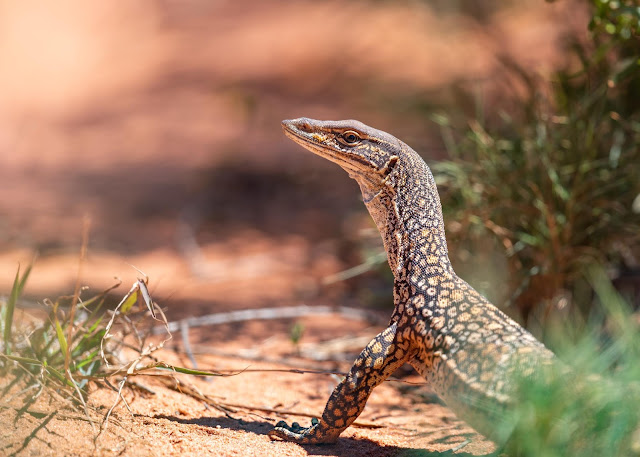The drive to Busselton was less than 3 hours so we arrived with plenty of time to choose a caravan park. We settled on one with ensuite sites that could accommodate us for 4 nights - which we later extended to 5 nights. We enjoyed beautiful weather and the opportunity to do some touristy things.
 |
| Red-capped Parrots around the caravan park late in the afternoon. |
 |
| Common Bronzewings were, as the name suggests, common. |
Busselton Jetty Underwater Observatory - this really is a great place to visit. It costs $34 per person, which includes a ride along the jetty to the observatory, and back, in the train. Once at the observatory visitors take part in a 15 minute guided tour then have another hour or so to wander around revisiting the various levels. The guide was available throughout to answer questions, identify creatures and to share the excitement when something unusual is spotted.
 |
| Pylon covered in soft corals. |
 |
| Wrasse |
 |
| I'm not sure what this one is. |
 |
| Crested Morwong |
 |
| Trigger fish |
Busselton Jetty - saved from destruction by a community group and now administered by a not for profit organisation. The small fee - $4 per person - allows visitors to walk the 1.84 kilometre jetty. This jetty is the longest wooden jetty in the southern hemisphere and the second longest in the world.
 |
| The little engine runs passengers out to the end of the jetty and back. |
 |
| Coming back in the train. It would have been a great walk but we chose the easy way. |
 |
| We were lucky to have perfect weather. |
 |
| A beautiful day to be at the beach. |
 |
| The end. |
Cape Naturaliste Lighthouse - Mick had a tip about a possible bird sighting within the lighthouse precinct so we drove over for a look. After taking the lighthouse loop walk which went around tne headland, we paid our $5 per person to enter the lighthouse precinct. An extra fee is payable if you want to do the tour and climb the lighthouse.
 |
| Lots of flowering banksias on the lighthouse walk. |
 |
| First view of the lighthouse. |
 |
| A different view on the walk |
Pioneer Cove Bird Hide - located in the Vasse River Delta, we found the hide following some directions we found in a birdwatching brochure. This is one of the better hides we have visited - it had a screened entrance as well as lots of interesting and useful interpretative information. It was also fairly clean and tidy. Someome must be looking after it.
 |
| A couple of good birds to be seen close by but too high for good pics. |
 |
| Blue-billed Duck |
 |
| Hoary-headed Grebe |
Markets - we always look out for local markets when we visit a place. Over the weekend we found the Lions Market in Dunsborough, as well as the Dunsborough Men's Shed sale on Saturday and the Busselton Rotary Markets on Sunday.






































